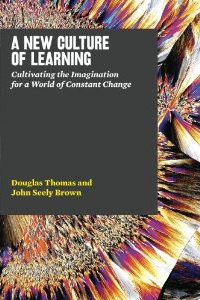
Quote: “In the twenty-first century, however, knowledge is becoming less a question of ‘What is the information?’ and more of a ‘Where is the information?’” (Thomas, 2011, p.91). I chose this quote for this chapter because it sums up the way learning occurs in the twenty-first century. In a National Geographic Survey, only 63% of 18 to 24 year olds could find Iraq on a map, but when asked to find Iraq using technology, 100% of 18 to 24 year olds could find it. The emphasis in education needs to shift from content-based knowledge, to process-based knowledge - where is the information, instead of what is the information.
Question: How do we shift towards this type of learning when testing is still highly content-based knowledge?
Connection: This chapter really resonated with me because I have seen a significant shift in my own life and society as a whole from relying on content-based knowledge to process-based knowledge. When chatting with friends about a certain topic and a question comes up, what do we do? We look it up online. Most of us have a smartphone and we are able to find the answer within minutes of searching. If this is what learning looks like in the real world, why are we still expecting our students to memorize content that can easily be found by searching online?
Epiphany/Aha: The very first sentence of this chapter is “The truism, ‘you live, you learn,’ lies at the heart of the new culture of learning” (Thomas, 2011, p.90) was an epiphany for me. I am completing my 20Time project on coding right now and I have a much better understanding of it now that I’ve tried it myself. If I had just researched and read about it I would have only a fraction of the learning that I do from completing it myself. Students need to have the same experience. You learn so much better by doing than by reading about doing.
Chapter 8 - Hanging Out, Messing Around, and Geeking Out
Quote: “Digital networked environments do not provide only an extension of real-world interaction; they also provide an enhanced environment for sharing information and engaging in meaningful social interaction” (Thomas, 2011, p.101). I chose this quote because I think it explains the concept behind the three levels of the progression of digital networking. First, you use digital networks to socialize and develop a social identity online (hanging out). Then, you begin to explore what digital networks are interesting to you personally to learn more about topics of interest (messing around). Lastly, you combine your online social identity with your interests and you deeply explore the networks for self-promoted learning (geeking out). Digital environments provide an “enhanced environment” for learning (Thomas, 2011).
Question: What does this look like in a classroom and how would you implement the steps to get there? I would love for my students to be self motivated to deeply immerse themselves into self-promoted learning, but I don’t know how to begin.
Connection: I feel like this chapter perfectly describes my EDL 680 course: Seminar in Personalized Learning and Leading with Technology. First we had to establish our social identity online by participating on twitter, instagram and blogging. Then we had to begin exploring digital networks that are interesting to us to complete our 20Time projects. Lastly, we will move onto immersing ourselves in digital networks for self-promoted learning to complete our final presentation for our 20Time project that has to have a Ted Talk feel to it. Not to mention, our grades depend on three digital badges that are named after the three levels in the progression. Perfectly named.
Epiphany/Aha: I never thought of digital networking as progressing in levels, but now that it has been outlined by Thomas (2011) it makes sense. I would love to move my students through the different levels throughout the year to immerse them in digital networking to support their learning.
Chapter 9 - The New Culture of Learning for a World of Constant Change
Quote: “Imagine an environment where the participants are building, creating, and participating in a massive network of dozens of databases, hundreds of wikis and websites, and thousands of message forums, literally creating a large-scale knowledge” (Thomas, 2011, p.106). I chose this quote because this chapter outlines how gaming is the best way for students to learn because they work collectively to find solutions to problems, but in the process they unearth more questions. This leads to a continuous learning cycle in which play and imagination are key to solving problems.
Question: Is Thomas suggesting we completely throw out the traditional way of teaching and move students to only learn through gaming? I agree it is a wonderful way to learn, but I’m not sure it completely replaces all forms of learning.
Connection: My students participated in Minecraft day this year where they collaborated to build a city using Minecraft because our school won a free day of coding at our Code to the Future campus. The CFO of Minecraft attended the event and our superintendent talked to me about incorporating Minecraft into teaching. At first I was really confused and didn’t know how Minecraft could be used for teaching. Now I see that they are embracing the new culture of learning and I am thrilled that my district is forward thinking and so technologically inclined.
Epiphany/Aha: Gaming isn’t about winning a game. Gaming is about allowing students to engage in a collaborative learning environment to use their imaginations to come up with creative solutions to problems. Thomas (2011) states “In fact, the ability to play may be the single most important skill to develop for the twenty-first century” (p.114). I didn’t understand this concept until reading this chapter.
Resources
Thomas, D., & Brown, J. (2011). A new culture of learning: Cultivating the imagination for a
world of constant change. Lexington, KY: CreateSpace Independent Publishing
Platform.